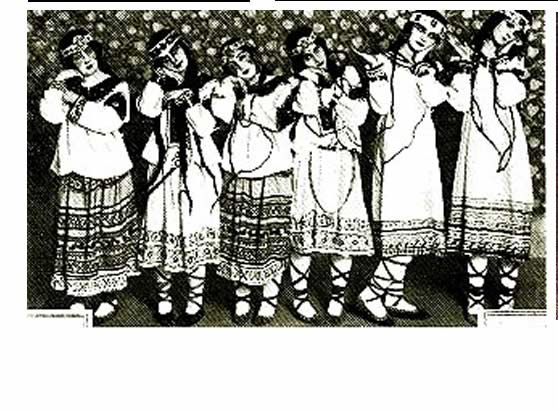The Rite of Spring,
composer Igor Stravinsky;
choreographer Vaslav Nijinsky;
designer Nicholas Roerich.
First produced
Theatre des Champs Elysees, Paris 29.5.1913
Theatre Royal, Drury Lane London 11.7.1913
Second version
Theatre des Champs Elysees, 15.12.1920.
Princes Theatre London 27.6.1921, choregraphy by Leonid Massine.
'No theatre
spectacle of this century has stirred up such a fury of excitement. None
today is less well known in its visual detail." M.Ledermann, Stravinsky
in the Theatre, 1957.
The
Sequence Part One ; The Adoration of the Earth
Introduction
Auguries of Spring(dances of young girls)
Mock Abduction
Spring Khorovod (Round Dance)
Games of the Rival Clans
Procession of the Wise Elder
Adoration of the Earth (The Wise Elder)
Dance of the Earth
Part Two The Sacrifice
Introduction (originally Pagan Night)
Mystical Circles of Young Girls
Glorification of the Chosen Victim
The Summoning of the Ancients
Ritual of the Ancients
Sacrifical Dance (The Chosen Victim)
TEXTS; INTERPRETATION
1. Stravinski's first idea for Le Sacre, while finishing The Firebird;
he"saw in imagination a solemn pagan rite; wise elders seated in
a circle, watching a young girl dancing herself to death. They were sacrificing
her to propitiate the god of spring." Chronicle (1935) After Petrouchka
had been successfully launched, Stravinsky consulted his friend Roerich
who was a painter and an archaelogist. First ideas for the scenery were
sketched out by Stravinsky and Roerich in the house of the Princess Tenisheva
in July 1911.
2. Roerich to Diaghalev cJan 1913, "my object is to present a number
of scenes of earthly joy and celestial triumph as understood by the Slavs.....
My intention is that the first set should transport us to the foot of
a sacred hill, in a lush plain where Slavonic tribes are gathered together
to celebrate the spring rites. In this scene there is an old witch, who
predicts the future, a marriage by capture, round dances. Then comes the
most solemn moment. The wise elder is brought from the village to imprint
his scared kiss on the new flowering earth. During this rite the crowd
is seized with a mystic terror..... After this uprush of terrestial joy
the second scene sets a celestial mystery before us. Young virgins dance
in circles on the sacred hill amid enchanted rocks; then they choose the
victim they intend to honour. In a moment she will dance her last dance
before the ancients clad in bearskins to show that the bear was man's
ancestor. The the greybeards dedicate the victim to the god Yarilo."
(The God of Light)
3. Nijinsky's note in the programme."It is really the soul of nature
expressed by movement to music. It is the life of the stones and the trees.
There are no human beings in it."
Sergei Diaghilev
RESPONSES IN THE BRITISH PRESS 1913.
1. The Times 26.7.13 ; "In Le Sacre du Printemps ...the functions
of the composer and the producer are so balanced that it is possible to
see every movement on the stage and at the same time to hear every note
of the music. But the fusion goes deeper than this. The combination of
the two elements of music and daancing does actually produce a new compound
result, expressible in terms of rhythm - much as the combination of oxygen
and hydrogen produces a different compound, water. Not only does M.Roerich's
beautiful scenery also form an important part of the whole, but even the
colours of the dresses are to some extent reflected in the orchestration
- as for instance in the first scene, when a group of maidens in vivid
scarlet huddles together to the accompnaiment of closely written chords
on the trumpets. Movements too are mirrored in an equally realistic way
when, a little later on, the dancers thin out into a straggling line,
while the orchestra dwindles to a trill on the flutes; then a little tune
develops in the woodwind two octaves apart, and two groups of three people
detach themselves from either end of the line to begin a little dance
that exactly suits the music."
2. Daily Mail (Richard Capell) July 12, 1913 , " Its savagery is
horrific. Dissonances extraordinary enough have been sought out by other
composers of the day to stir our jaded senses with a new thrill. But no
one has gone so ferociously to work as M.Stravinsky, and no one has drummed
and dinned his dissonances with such maddening rythmic persistency. And
it must be added that all this is uttered by the most outlandish orchestral
cries and groans, with masses of wind instruments mainly playing in unaccustomed
registers."
3. Jean Cocteau writing in Le Coq et l'Harlequin (1918)
reviewed the symbolism of The Rite,"When she falls dead, the ancestors
draw near, receive her body and raise it towards heaven. This theme, so
simple, so devoid of symbolism - today seems to hold a symbol. I see in
it the prelude to war."
Ballets in London
1911 Le Spectre de la Rose
1912 L'Oiseau de Feu
1913 Petrouchka
L'Apres Midi d'un Faun
Le Sacre du Printemps
Jeux
1914
Daphnis et Chloe.
Some artists who have worked with Diaghalev as designers of sets and
costumes.
Bakst
L'Oiseau du Feu 1910
Benois Petrouchka 1913
Mikhail Larionov Chou t 1921
Miro Jeux d'Enfants 1932
Picasso Le Train Bleu 1924
Giorgio de Chirico Le Bal 1929
Henri Matisse Le Chant de Rossignol 1914
scene from a performance of The Rite
The following ballets are to be found in performance on film ,
Spectre de la Rose ,
Les Noces ,
Petrouchka ,
Le Sacre ,
L'Apres Midi .
BOOKLIST
exhib.catal The Diaghalev Ballet in England, Univ.East
Anglia 1980
N.Macdonald Diaghalev Observed Dance Books Lond1975
Richard Buckle Nijinsky 1971
Richard Buckle Diaghalev 1979
Sotheby Sale catal. Costumes and Curtains 17 July
1968
Ballet Material 9,10 July 1969
Ballet Material and Theatre Material 16 December
1969
Costumes and Curtains 19 December 1969

to Sales of Diaghilev Ballet Costumes
|

















